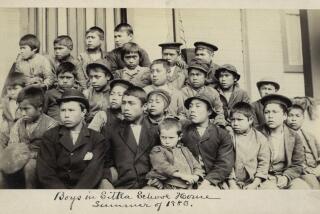FILM REVIEW : The Times Now Seem Right for ‘The Plot Against Harry’
- Share via
In the 1960s, Michael Roemer, who made the trail-blazing racial drama “Nothing But a Man” with partner Robert M. Young in 1965, was one of the nation’s most promising independent film makers.
But, in the ‘70s, he faded into the fringes of film and academia--teaching at Yale, writing occasional essays and emerging infrequently as a film maker for PBS and “American Playhouse.” Now, in a delightful storybook reversal, Roemer is back in the critics’ spotlight, thanks to “The Plot Against Harry” (now playing at the Ken), the very film that drove him away 20 years ago. Back in 1969, early screening audiences found it unfunny and off-putting, studios rejected it for distribution, and Roemer, exhausted and disappointed, put it on the shelf. While we can only speculate on the films Roemer might have made if “The Plot Against Harry” had found its audience in 1969, it is happily here to appreciate now: a balmy, deliciously deadpan, Jewish gangster comedy that takes a wry, sneaky peek into the seamier sides of urban Jewish culture. Its milieu of hectic bar mitzvahs, dotty middle-class clans, Mafioso suburban barbecues, secret pseudo-Masonic ceremonies, daft heart telethons and brassiere models studying the ballet is exposed with a sly mix of affection and lacerating satire.
Martin Priest is the Harry Plotnick of the title, a schlemiel of a gangster who’s run afoul of both his clientele and his one-time Mafia protectors. Plotnick’s motor has run down: a weary old businessman with an apparently bum heart, fresh out of jail, who worked his way up through the rackets, he now finds his empire crumbling--at the same time a chance reunion with his divorced family prompts him to go legit.
There is nothing malicious about Harry. He may have been a bad husband, but he is nice to his kvetch of a sister, Mae (Ellen Herbert) and his corpulent klutz of a bookkeeper-gofer (songwriter Henry Nemo). Roemer is very careful to show us, three years before Coppola’s “The Godfather,” that there’s not much moral or social difference between Harry and the straight businessmen whose world he wants to crash: his numbers rival, Big Julie (Julius Harris), is merely obeying the laws of commerce and the changing neighborhood.
In this world, paranoia, business, crime and family are all weirdly intertwined. Made originally during a minor American Jewish movie renaissance, when Woody Allen, Mel Brooks and Paul Mazursky were all directing their first films, “Harry” lacks their overtly fantastic-comic edge. It buries its comic knives under a seemingly conventional, right-off-the-rack surface.
Roemer is a documentary maker and social realist and his closely detailed, low-key approach may have worked against the humor back in 1969: the era of psychedelia, jump-cuts and wild, snazzy, sometimes elliptic film making. Here, the photography of Robert M. Young--who went on to a strong solo directorial career himself (“Triumph of the Spirit”)--is black-and-white, the compositions are flat, functional and unflashy.
The strength of “Harry” lies almost entirely in its unusual humanity, the depth of its social observations and its determination to draw everything--even the comic exaggerations--from life.
In the opening scene, Priest plays his character--who’s going to suffer a seizure shortly through--with such enervated, exhausted rhythms, it’s easy to see what may have failed to connect with screening audiences in 1969. But you’d be wise to wait this time for the appearance of Ben Lang, as Harry’s seraphically smiling brother-in-law and catering partner, Leo Perlmutter. When Lang comes on, his unctuous nonstop grin lights up the screen. The comic rhythms suddenly take hold. Ebullient Leo becomes the perfect contrast for haggard Harry. The whole film suddenly seems more confident and bubbly, though Lang--who made this one film before moving back to an auditor’s job at the New York Department of Labor--may have been the main casualty of the movie’s nonrelease.
It’s hard to imagine he wouldn’t have won more roles if “Harry” had been seen in 1969. “The Plot Against Harry” was not exactly ahead of its time. One of the reasons it looks good now, in fact, may be that it’s so resolutely of that time. It doesn’t succumb to the 1980s vices of weak stories and characters, scrubbed-up milieus and archetypal conflicts.
It’s a movie that’s about something: the collision of old and new values, the thin line that separates crime and organized business, the wary complex bonds between families. That engagement keeps it fresh now. In 1969, Roemer might have been accused of airing dirty laundry--something Spike Lee or even Mazursky and Allen are sometimes accused of today. Now the laundry itself carries a whiff of nostalgia.
In “The Plot Against Harry” (Times-rated Mature for language and sex), Harry the sad-eyed, failing gangster is just one more victim of urban change, kitsch culture and modern business methods. Like Joseph K in “The Trial,” the plot against him is life itself.
More to Read
Only good movies
Get the Indie Focus newsletter, Mark Olsen's weekly guide to the world of cinema.
You may occasionally receive promotional content from the Los Angeles Times.










